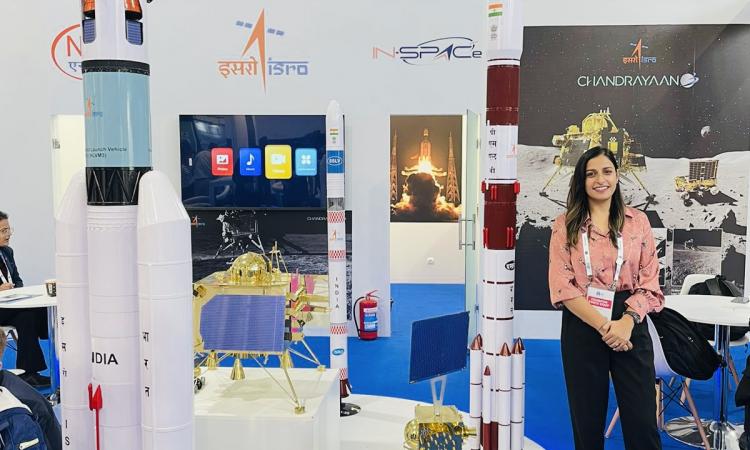
When it comes to water management, we have predominantly covered the work of civil society actors and government in the past. But in recent years, we have seen several highly innovative, market based approaches to solving India’s water security challenges. In our recent partnership with The Nudge Foundation for a challenge for such entrepreneurs, we came across a few that were founded and led by women who have achieved extraordinary feats in converting their ideas into marketable products and services. One such water warrior is Dr. Jagriti Dabas, who has a Ph.D. in Energy & Environment, an MSc in Geoinformatics, and a B.Sc. (H.) in Physics; and is the founder of Arms4AI, a geo-AI platform for geospatial insights from space to be used in agriculture, environment, infrastructure, and defence.
Her startup has received support from INSPACE, DPIIT, STARTUP INDIA, MEITY, STPI, WEHUB, and AIM. Arms4AI already has a great client base, amongst which is the Government of Maharashtra, Kazakhstan government, Raipur Nagar Nigam, and DCM Shriram.
We share excerpts from her interview with the India Water Portal.
What was your journey to Arms4AI like?
I was intrigued by geospatial and space technology during my masters at the TERI School of Advanced Studies. I first co-founded a consulting firm with my batchmates that specialised in geospatial services. But recognising the importance of AI in the field, I transitioned to focusing on artificial intelligence (AI) technology. I enrolled in some courses where I learned about machine learning and deep learning and applied some of the algorithms.
After analysing numerous market trends, I realised why AI is important, especially the automation part. Automation will help us spend more time on the analytics or decision-making rather than on data preparation. This is what inspired me to work in the field of AI and create Arms4AI.
How does your work intersect with water? What is the potential of using AI for long term water management in India?
Amongst the four verticals that we have, i.e., agriculture, environment, infrastructure, and defence, water is a major part of the first two. Talking specifically about agriculture, technology intervention can help revenue incentivisation for farmers in both the short and long term. AI is nothing but human intelligence transformed into machines. Using geospatial AI that is supported by space technology, we can issue advisory and support for interventions using satellite data. We use a comprehensive farm diagnosis and support farmers with day-to-day decision-making, especially with water guzzling cash crops like sugarcane, through digitised technological methods. This has huge potential to shape agriculture's water use in India.
Can you share a case or experience of having deployed your idea in water? What were your learnings?
In a case study project on sugarcane in India, we realised that farmers in India have low economic costs of water use and this makes flood irrigation very common. Farmers continue doing this because that is what has been done for decades but their decisions are not driven by data. In the case study, we found that half the time, water was not required at all and irrigation was not resulting in any better yield, so there is a huge potential to save water.
Of course, there are social challenges to gaining acceptance of this data as it is against traditional practices but we are using advisory to translate this into action on the ground. Water saving is not a priority for farmers, its cost is barely 5% of their total farming costs. So, the tools we provide them have to do more for them—like increase their yield and income and reduce their expenses.
What is your vision for India to use AI for social and development goals like water security? What are the factors that can enable it or hinder its progress?
After Digital India and the success of UPI, every individual in India, including a farmer, uses smartphone. People are very open and accepting of technology and receptive to new tools. However, the willingness to pay for a new tool is very low, especially for small farmers who do not make large profits from farming. What we are trying to do for water has larger implications on the environment and ecosystem at large, and can support the pathways to a water secure future. We are pricing our product at a very low cost, almost as low as prepaid phone tariff in India, and farmers can subscribe to it once they start seeing benefits and increase in revenue. There is more potential for use of AI in similar fields in India and it should definitely be explored.
What message would you like to share with all the women reading this? What do you encourage us to do more of?
India is a huge market and there is a large demand for innovation. Everyone can have a share of it for their ideas. Don’t let the fear of competition and resistance in the market deter you. What we see now in terms of market and demand is just the tip of the iceberg. Even beyond water and in allied areas like carbon, natural resources management, etc, there is potential for several solutions and innovations. Women are very smart, and especially great at bringing about savings, so more of us should come up with our ideas.
The ecosystem is very receptive for entrepreneurship right now, and you can get support from multiple avenues. There are also special schemes for women to help succeed, and my personal experience has been very positive.
/articles/women-shaping-indias-water-security-through-social-enterprises